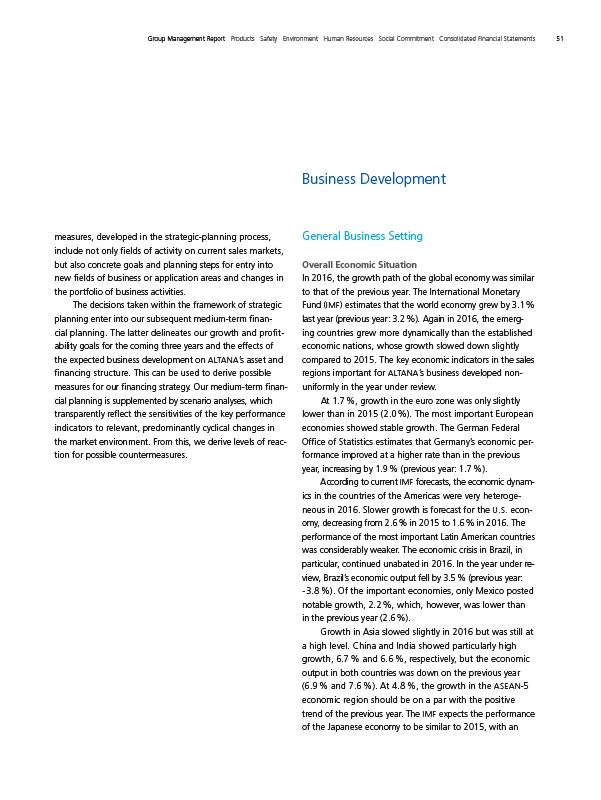
Group Management Report Products Safety Environment Human Resources Social Commitment Consolidated Financial Statements 51
measures, developed in the strategic-planning process,
include not only fields of activity on current sales markets,
but also concrete goals and planning steps for entry into
new fields of business or application areas and changes in
the portfolio of business activities.
The decisions taken within the framework of strategic
planning enter into our subsequent medium-term finan-
cial planning. The latter delineates our growth and profitability
goals for the coming three years and the effects of
the expected business development on ALTANA’s asset and
financing structure. This can be used to derive possible
measures for our financing strategy. Our medium-term financial
planning is supplemented by scenario analyses, which
transparently reflect the sensitivities of the key performance
indicators to relevant, predominantly cyclical changes in
the market environment. From this, we derive levels of reaction
for possible countermeasures.
Business Development
General Business Setting
Overall Economic Situation
In 2016, the growth path of the global economy was similar
to that of the previous year. The International Monetary
Fund (IMF) estimates that the world economy grew by 3.1 %
last year (previous year: 3.2 %). Again in 2016, the emerg-
ing countries grew more dynamically than the established
economic nations, whose growth slowed down slightly
compared to 2015. The key economic indicators in the sales
regions important for ALTANA’s business developed non-
uniformly in the year under review.
At 1.7 %, growth in the euro zone was only slightly
lower than in 2015 (2.0 %). The most important European
economies showed stable growth. The German Federal
Office of Statistics estimates that Germany’s economic per-
formance improved at a higher rate than in the previous
year, increasing by 1.9 % (previous year: 1.7 %).
According to current IMF forecasts, the economic dynamics
in the countries of the Americas were very heteroge-
neous in 2016. Slower growth is forecast for the U.S. econ-
omy, decreasing from 2.6 % in 2015 to 1.6 % in 2016. The
performance of the most important Latin American countries
was considerably weaker. The economic crisis in Brazil, in
particular, continued unabated in 2016. In the year under re-
view, Brazil’s economic output fell by 3.5 % (previous year:
- 3.8 %). Of the important economies, only Mexico posted
notable growth, 2.2 %, which, however, was lower than
in the previous year (2.6 %).
Growth in Asia slowed slightly in 2016 but was still at
a high level. China and India showed particularly high
growth, 6.7 % and 6.6 %, respectively, but the economic
output in both countries was down on the previous year
(6.9 % and 7.6 %). At 4.8 %, the growth in the ASEAN-5
economic region should be on a par with the positive
trend of the previous year. The IMF expects the performance
of the Japanese economy to be similar to 2015, with an